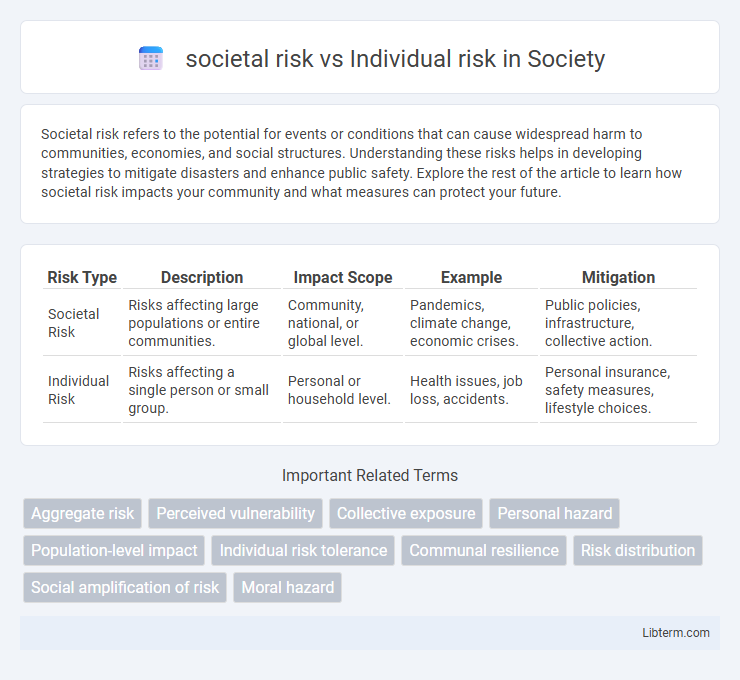Societal risk refers to the potential for events or conditions that can cause widespread harm to communities, economies, and social structures. Understanding these risks helps in developing strategies to mitigate disasters and enhance public safety. Explore the rest of the article to learn how societal risk impacts your community and what measures can protect your future.
Table of Comparison
| Risk Type | Description | Impact Scope | Example | Mitigation |
|---|---|---|---|---|
| Societal Risk | Risks affecting large populations or entire communities. | Community, national, or global level. | Pandemics, climate change, economic crises. | Public policies, infrastructure, collective action. |
| Individual Risk | Risks affecting a single person or small group. | Personal or household level. | Health issues, job loss, accidents. | Personal insurance, safety measures, lifestyle choices. |
Understanding Societal Risk vs Individual Risk
Understanding societal risk involves assessing the potential impact of hazards on large populations, infrastructure, and communities, often measured in terms of fatalities, economic loss, or disruption to critical systems. Individual risk focuses on the probability and consequences of harm to a single person, emphasizing personal exposure and vulnerability. Balancing societal risk and individual risk evaluation is crucial for informed policy-making, resource allocation, and risk mitigation strategies.
Key Differences Between Societal and Individual Risks
Societal risk refers to the probability and impact of events causing widespread harm across a population, emphasizing collective consequences such as economic loss or public health crises, while individual risk pertains to the likelihood and severity of harm affecting a single person. Key differences include scale of impact, where societal risks involve large groups or communities, and individual risks focus on personal exposure or susceptibility. Risk assessment methods also vary, with societal risk often quantified through aggregated data and statistical models, whereas individual risk assessments are tailored to personal behaviors, genetics, or environmental factors.
Historical Perspectives on Risk Assessment
Historical perspectives on risk assessment reveal a divergence between societal risk, which evaluates potential harm to communities or populations, and individual risk, focusing on personal likelihood of adverse outcomes. Early frameworks prioritized individual risk through probabilistic calculations, while evolving sociotechnical systems highlighted the importance of societal risk, accounting for cascading effects and collective vulnerability. Landmark studies, such as those following industrial disasters, underscored the need to balance individual safety measures with comprehensive societal risk management strategies.
Factors Influencing Societal Risk Perception
Societal risk perception is influenced by factors such as the potential scale of impact, media coverage intensity, and the degree of voluntary exposure to the hazard. Risks perceived as uncontrollable or catastrophic tend to evoke stronger societal concern compared to those considered familiar or manageable. Cultural values, trust in institutions, and personal experience with similar risks also play critical roles in shaping collective risk assessments.
Personal Choices and Managing Individual Risk
Personal choices play a crucial role in managing individual risk by influencing exposure to hazards and promoting preventive behaviors. Understanding individual risk empowers people to adopt tailored strategies such as lifestyle adjustments, safety practices, and health screenings that mitigate personal vulnerability. Societal risk frameworks complement these efforts by providing resources, regulations, and community support to enhance individual decision-making and reduce overall harm.
Collective Impact: Societal Risk in Public Policy
Societal risk in public policy refers to the aggregated potential harm affecting large populations, emphasizing the collective impact of decisions on community health, safety, and wellbeing. Unlike individual risk, which assesses personal likelihood of harm, societal risk evaluates systemic vulnerabilities and the probability of widespread consequences. Effective public policies prioritize minimizing societal risk by addressing structural factors, enhancing resilience, and ensuring equitable resource allocation for disaster prevention and recovery.
Case Studies: Societal vs Individual Risk in Real Life
Case studies such as the Fukushima nuclear disaster highlight societal risk by demonstrating widespread impacts on communities, economies, and environments, whereas the individual risk primarily concerns personal health and safety near the affected zones. The COVID-19 pandemic offers another example, where societal risk encompasses global public health crises, economic disruptions, and policy responses, contrasting with individual risk factors like personal susceptibility and exposure levels. Examination of these cases underscores the complexity of balancing collective safety measures while addressing personal risk perceptions and behaviors.
Balancing Regulation and Personal Freedom
Balancing societal risk and individual risk requires regulatory frameworks that protect public health while respecting personal autonomy. Effective regulation prioritizes minimizing harm to communities through evidence-based policies without imposing undue restrictions on individual freedoms. Striking this balance ensures collective safety and supports personal responsibility in risk management decisions.
Ethical Considerations in Risk Management
Ethical considerations in risk management require balancing societal risk--potential harms affecting large populations--with individual risk impacting personal well-being. Decision-makers must ensure transparency, equity, and justice while mitigating risks, prioritizing vulnerable groups and avoiding disproportionate burdens on individuals. Incorporating ethical frameworks enhances trust and accountability in policies addressing both collective and individual safety.
Future Trends in Risk Analysis and Mitigation
Future trends in risk analysis and mitigation emphasize the integration of advanced data analytics and machine learning to differentiate societal risk from individual risk more accurately. Emerging technologies enable real-time monitoring and predictive modeling, enhancing the capacity to address systemic vulnerabilities while tailoring interventions to individual risk profiles. Enhanced collaboration between public health, urban planning, and cybersecurity sectors drives the development of comprehensive frameworks that balance societal resilience with personalized risk management strategies.
societal risk Infographic

 libterm.com
libterm.com